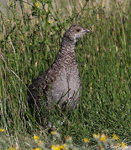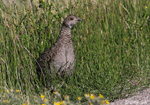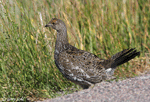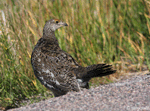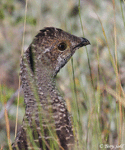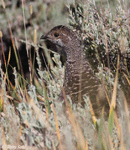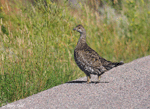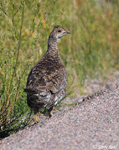| Length: 18 - 20 inches | Wingspan: 24 - 28 inches | Seasonality: Likely extirpated from South Dakota |
| ID Keys: Gray-tip on dark tail, gray overall, orange comb above eyes (male), reddish neck sack surrounded by white feathers (male). | ||
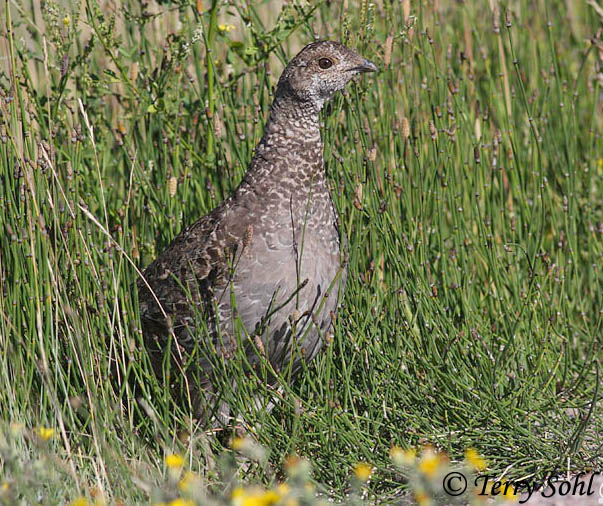 Until recently, the Dusky Grouse and the Sooty Grouse were considered one species, the
Blue Grouse. The Dusky and Sooty Grouse are large grouse of mountain
forests of the West. The Dusky Grouse is the species found in more
interior locations of North America, while the Sooty Grouse is found in areas
near the Pacific Coast. Only the 2 Sage Grouse species are larger amoung
North American grouse species. Observations of the species were made in
the Black Hills during the 1800s, but the species was probably extirpated from
the state by 1900 (Birds of South Dakota -- SDOU, 2001). Reintroduction
efforts since that time have evidently been unsuccessful, with no observed birds
more than 2 years after any reintroduction attempt.
Until recently, the Dusky Grouse and the Sooty Grouse were considered one species, the
Blue Grouse. The Dusky and Sooty Grouse are large grouse of mountain
forests of the West. The Dusky Grouse is the species found in more
interior locations of North America, while the Sooty Grouse is found in areas
near the Pacific Coast. Only the 2 Sage Grouse species are larger amoung
North American grouse species. Observations of the species were made in
the Black Hills during the 1800s, but the species was probably extirpated from
the state by 1900 (Birds of South Dakota -- SDOU, 2001). Reintroduction
efforts since that time have evidently been unsuccessful, with no observed birds
more than 2 years after any reintroduction attempt.
Habitat: Summer habitat is generally deciduous and mixed forests, primarily along forest edges. They move to higher elevation conifer forest during the winter months, primarily in dense stands.
Diet: Conifer needles make up a large portion of the diet, especially during the winter months. Also feeds on other plant material including berries, shoots and buds, leaves, and flowers. Will also feed on insects.
Behavior: Primariliy forages on the ground during the summer months, when the diet includes many insects, berries, flowers, and leaves. During the winter months, the diet is dominated by conifer needles, and foraging behavior changes, with birds foraging in evergreen trees.
Nesting: Likely used to breed in South Dakota prior to the start of the 20th century, but now extirpated and a non-breeder in the state.
Song: Loud deep hoots by the displaying male. Also cackling and clucking sounds.
Migration: Semi-permanent residents throughout their range, although birds do make general moves from more open areas during breeding season to dense conifer forest during the winter.
Interactive eBird Map: Click here to access an interactive eBird map of Dusky Grouse sightings
Similar Species: Most similar to the Sooty Grouse, but could also be confused with the Spruce Grouse, Ruffed Grouse
Conservation Status: Extirpated from South Dakota, where they were once found in the Black Hills. Still fairly common in parts of their range, although forest management practices associated with the timber industry are detrimental to their survival and they are declining in some areas. The IUCN still lists the Dusky Grouse as a species of "Least Concern".
Further Information: 1) BirdLife International - Dusky Grouse
2) Audubon Guide - Dusky Grouse
3) Montana Field Guides - Dusky Grouse
Photo Information: August 18th, 2008 - Bighorn Mountains of Wyoming - Terry Sohl
| Click on the map below for a higher-resolution view |
 |
| South Dakota Status: Blue Grouse were once found in the Black Hills of South Dakota, but were likely extirpated in the late 1800s. Multiple reintroduction efforts have been made in the Black Hills in the latter part of the 20th century, evidently without success. Note the range map above shows the range for all "Blue Grouse", including both "Dusky" and "Sooty". |
Additional Blue Grouse Photos
Click for a higher-resolution version of these photos
